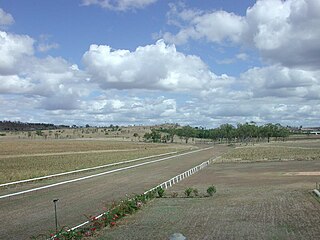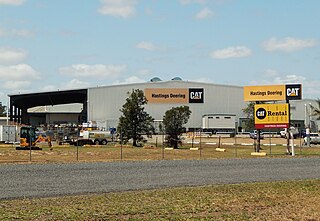Related Research Articles

Rockhampton is a city in the Rockhampton Region of Central Queensland, Australia. The population of Rockhampton in June 2021 was 79,967, making it the fourth-largest city in the state outside of the cities of South East Queensland, and the 22nd-largest city in Australia. Today, Rockhampton is an industrial and agricultural centre of the north, and is the regional centre of Central Queensland.

Duaringa is a town in the Central Highlands Region and a locality split between the Central Highlands Region and the Aboriginal Shire of Woorabinda in Central Queensland, Australia. In the 2021 census, Duaringa had a population of 262 people.

Central Queensland Capras are a semi-professional rugby league football club primarily based in Rockhampton, Queensland and representing Central Queensland. They currently play in the Queensland Cup, the premier rugby league competition in Queensland. From 2023, they will serve as one of the feeder clubs for the Dolphins.

Browne Park is a rectangular football stadium located in the Rockhampton suburb of Wandal, Queensland, Australia. The venue has been the home of rugby football in Central Queensland since 1890 and today also hosts rugby union and soccer matches. It hosted a match of the 2008 Rugby League World Cup. The ground was named Browne Park in 1958 as a posthumous honour to long serving president of Rockhampton Rugby League, Jack Browne who died in office.
A race caller is a public-address announcer or sportscaster who describes the progress of a race, either for on-track or radio and TV fans. They are most prominent in horse racing, auto racing and track-and-field events.

Rockhampton City is the central suburb of the city of Rockhampton in the Rockhampton Region, Queensland, Australia. In the 2016 census. Rockhampton City had a population of 1,953 people. It is informally known as Rockhampton central business district (CBD).
An outbreak of equine influenza (EI) in Australia was confirmed by the Department of Primary Industries on 24 August 2007 in Sydney. Also known as "horse flu" and "A1 influenza", the rapid outbreak was of the Influenza A virus strain of subtype H3N8. While the virus is highly contagious, it rarely kills adult horses but the performance of thoroughbred racing horses can be affected for several weeks. It can be fatal to young foals and debilitated horses.

Gayndah Racecourse is a heritage-listed racecourse at Fisher Avenue, Gayndah, North Burnett Region, Queensland, Australia. It was built c. 1855. It is also known as Gayndah Race Track. It was added to the Queensland Heritage Register on 12 September 2005.
Graeme William Acton was an Australian cattle baron, who was also known for his involvement in the Australian sport of campdrafting.

Port Curtis is a suburb in the Rockhampton Region, Queensland, Australia. In the 2016 census Port Curtis had a population of 281 people.
Beef Australia is an international exposition held triennially in Rockhampton, Queensland, Australia. The week-long expo has been held in the city during the month of May triennially since the inaugural event in 1988. The event is promoted and used as an opportunity to facilitate international trade opportunities for those involved in the beef industry. However, it is also considered more generally as a celebration of the local beef industry in Central Queensland. In 2015, almost 90,000 people attended the event.
The Pilbeam Theatre is an indoor performance venue in Rockhampton, Queensland.
Rockhampton Zoo is a zoo in the Australian city of Rockhampton, Queensland.
The Neville Hewitt Bridge is a road bridge which spans the Fitzroy River in Rockhampton, Queensland, Australia. It was officially opened on 16 August 1980.
The Rockhampton Showgrounds is a multipurpose recreational venue in Rockhampton, Queensland, Australia. It is situated in the suburb of Wandal.
The 2018 Central Queensland bushfires were a series of 1,250 bushfires which ignited and moved across areas of the Central Queensland region of Australia in November and December 2018, during the 2018-19 Australian bushfire season.
Mulara is a rural locality in the Livingstone Shire, Queensland, Australia. In the 2016 census, Mulara had a population of 89 people.
Syeid Alam was an Australian man who was killed and then beheaded in Rockhampton, Queensland on 5 April 2016.
Sarah Field is an Australian rugby league player who plays as a five-eighth.
References
- ↑ Racecourses: Rockhampton, horseracing.com.au website. Accessed 13 April 2018.
- 1 2 3 4 5 6 7 8 9 10 11 12 13 14 15 16 About Us: History, Callaghan Park website. Accessed 12 April 2018.
- 1 2 3 McDonald, Lorna (1995) Rockhampton: A History of City & District (second edition). ISBN 0-9599897-3-0. Accessed 13 April 2018.
- 1 2 3 4 5 (6 December 1924) Dr. William Callaghan, The Morning Bulletin . Retrieved from National Library of Australia 13 April 2018.
- ↑ Rockhampton Hospital – a 150-year-old story, Australian Country Hospital Heritage Association Inc. website. Accessed 13 April 2018.
- ↑ Trustee Chambers (Entry 600802), Queensland Heritage Register. Accessed 14 April 2018.
- ↑ "Veno" (9 March 1912) Sporting News: The Turf, The Morning Bulletin. Retrieved from National Library of Australia 12 April 2018.
- ↑ (2 April 1912) Death of Dr. W. Callaghan, The Morning Bulletin. Retrieved 12 April 2018.
- ↑ (3 June 1912) Callaghan Park formally named, The Morning Bulletin. Retrieved from National Library of Australia 12 April 2018.
- ↑ (18 June 1918) Rockhampton Jockey Club: Cup Day, The Morning Bulletin. Retrieved 14 April 2018.
- ↑ Rockhampton Cup Winners results Archived 20 August 2013 at the Wayback Machine , Racerate website. Accessed 14 April 2018.
- ↑ (31 May 1919) Influenza: 8 Deaths in Brisbane... Death of Mr. Dawbarn at Rockhampton..., The Bundaberg Mail. Retrieved 14 April 2018.
- ↑ (11 September 2007) Rockhampton Jockey Club holds first meet since flu outbreak, ABC News , Australian Broadcasting Corporation. Retrieved 14 April 2018.
- ↑ (11 September 1922) Dead-heated three times, Cairns Post . Retrieved from National Library of Australia 13 April 2018.
- ↑ Turf Notes, The Telegraph . Retrieved from National Library of Australia 13 April 2018.
- ↑ (2 May 1938) Triple Dead-Heat at R.J.C. Races, The Morning Bulletin. Retrieved from National Library of Australia 13 April 2018.
- ↑ (30 April 1938) Triple Dead Heat at Rockhampton, The Telegraph. Retrieved 13 April 2018.
- ↑ (29 May 1922) Jockey badly injured, The Morning Bulletin. Retrieved 13 April 2018.
- ↑ (9 August 1937) Jockey Marshall Injured at Callaghan Park, The Morning Bulletin. Retrieved 13 April 2018.
- ↑ (13 April 1940) Jockey Marsden In Hospital, The Morning Bulletin. Retrieved 13 April 2018.
- ↑ (8 August 1940) Jockey Injured and Horse Dead, The Evening News. Retrieved from National Library of Australia 13 April 2018.
- ↑ (25 November 1946) Injured Jockey Flown To Brisbane, The Morning Bulletin. Retrieved 13 April 2018.
- ↑ (22 August 1949) Electric battery used on horse at Rockhampton, The Canberra Times . Retrieved 13 April 2018.
- ↑ Austin-Wright, Amber (11 June 2007) Six-Horse Fall at Callaghan Park, WIN News , WIN Television. Accessed 14 April 2018.
- ↑ (3 January 2008) Jockey 'won't walk again' after race accident, ABC News, Australian Broadcasting Corporation. Retrieved 12 April 2018.
- ↑ (8 April 2009) Jockeys recovering from fall, ABC News, Australian Broadcasting Corporation. Retrieved 12 April 2018.
- ↑ Fitzpatrick, Stephanie (27 May 2011) Three jockeys hurt in fall, ABC News, Australian Broadcasting Corporation. Retrieved 12 April 2018.
- ↑ McMahon, Tony (16 June 2015) Freak accident in Callaghan Park change rooms halts Evans, The Morning Bulletin, APN News & Media. Retrieved 12 April 2018.
- ↑ (23 June 2015) Jockey Sairyn Fawke's injuries are extensive, The Morning Bulletin, APN News & Media. Retrieved 12 April 2018.
- ↑ Roberts, Alice; Bradfield, Elly (16 October 2014) Queensland racing community mourns loss of Carly-Mae Pye, ABC Capricornia, Australian Broadcasting Corporation. Retrieved 12 April 2018.
- ↑ Race Schedule, Callaghan Park website. Accessed 13 April 2018.
- ↑ Racing Calendar, Rockhampton Greyhound Racing Club website. Accessed 13 April 2018.
- ↑ Fox, Sean (18 March 2018) Crowds flock to the St. Patrick's Day Races, The Morning Bulletin, News Corp Australia. Retrieved 12 April 2018.
- ↑ McMahon, Tony (7 April 2016) State's richest race to be run in Rocky on Saturday, The Morning Bulletin, News Corp Australia. Retrieved 12 April 2018.
- ↑ Hooker, Amber (7 May 2017) Track-side glamour at triumphant Callaghan Park race return, The Morning Bulletin, News Corp Australia. Retrieved 12 April 2018.
- ↑ Conway-Dodd, Zhanae (20 June 2016) Girls Grammar race day brings in crowds, The Morning Bulletin, News Corp Australia. Retrieved 12 April 2018.
- ↑ (6 June 2009) Sprint Attracts Quality Field, The Morning Bulletin, APN News & Media. Retrieved 12 April 2018.
- ↑ McMahon, Tony (15 June 2009) Leica launch takes Tatt's Cup, The Morning Bulletin, APN News & Media. Retrieved 12 April 2018.
- ↑ McMahon, Tony (19 June 2010) Newmarket brings huge nominations, The Morning Bulletin, APN News & Media. Retrieved 12 April 2018.
- ↑ (26 June 2016) Rocky Cup draws a crowd as Ruling Force snags victory, The Morning Bulletin, News Corp Australia. Retrieved 13 April 2018.
- ↑ Allen, Steph (19 October 2017) St Peter's Caulfield Cup Birdcage event tomorrow, The Morning Bulletin, News Corp Australia. Retrieved 14 April 2018.
- ↑ McDonald, Madeline (2 November 2016) Melbourne Cup day at Callaghan Park, The Morning Bulletin, News Corp Australia. Retrieved 14 April 2018.
- ↑ Lewis, Megan (10 December 2010) Callaghan Park consultations underway, ABC News, Australian Broadcasting Corporation. Retrieved 12 April 2018.
- ↑ Roberts, Alice; Robinson, Paul (10 July 2014) Aussie film shot at Rocky race track, ABC Capricornia, Australian Broadcasting Corporation. Retrieved 14 April 2018.
- ↑ McKay, Pam (11 July 2014) Cameras roll at Callaghan Park as part of new Aussie drama, The Morning Bulletin, APN News & Media. Retrieved 14 April 2018.
- ↑ (5 June 1912) Visit of Mr. A. B. Stone: Monoplane-Motor Car Race; The Flying Machine Damaged, The Morning Bulletin. Retrieved 12 April 2018.
- ↑ Haydock, Amy (20 June 2011) Monoplane crashes in rare race, The Morning Bulletin, APN News & Media. Retrieved 12 April 2018.
- ↑ Gately, Michelle (2 May 2017) Five shocking crimes that changed Rockhampton forever, The Morning Bulletin, News Corp Australia. Retrieved 12 April 2018.
- ↑ (25 August 2014) KERRISK Bradley Richard: Missing – Suspected Murder; $250,000 Reward, Queensland Police Service website. Retrieved 12 April 2018.
- ↑ (12 February 1990) Jockeys searched, The Canberra Times. Retrieved from National Library of Australia 13 April 2018.
- ↑ (11 May 1928) Callaghan Park Cleaning Up After Flood, The Telegraph. Retrieved 14 April 2018.
- ↑ (24 April 1940) May Cost £200 To Repair Damage; Effect of Flood at Callaghan Park, The Morning Bulletin. Retrieved 14 April 2018.
- ↑ (15 February 1954) Racecourse covered by floodwaters, The Morning Bulletin. Retrieved 14 April 2018.
- ↑ Robinson, Paul; Lewis, Megan; Timms, Penny (10 December 2010) Rockhampton continues flood preparations, ABC News, Australian Broadcasting Corporation. Retrieved 14 April 2018.
- ↑ Hatzakis, Maria (6 January 2010) Flood-hit racing industry promised financial aid, ABC News, Australian Broadcasting Corporation. Retrieved 14 April 2018.
- ↑ Robinson, Paul (27 March 2012) Predicted flooding closes Rockhampton race meet, ABC News, Australian Broadcasting Corporation. Retrieved 14 April 2018.
- ↑ Smith, Leighton (31 May 2017) Racetrack repairs running a record race, The Morning Bulletin, News Corp Australia. Retrieved 14 April 2018.
- ↑ Barry, Bridie (1 January 1997) Celebrations, WIN News, WIN Television. Accessed 14 April 2018.
- ↑ (27 May 2016) CQ Mega Lifestyle Expo delivers all the region has to offer, The Morning Bulletin, News Corp Australia. Retrieved 14 April 2018.
- ↑ (8 February 2018) Have your function track side, The Morning Bulletin, News Corp Australia. Retrieved 14 April 2018.